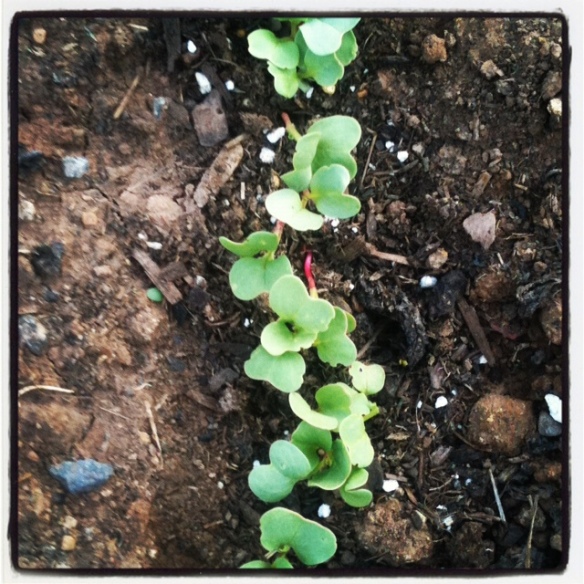Before you call Rogaine or sign me up for the Hair Club for Men as a special exception, let me clarify.
I knew this diagnosis was coming. It was just a matter of time before I would display any symptoms. When they finally showed up, they were more painful than I could have ever expected.
You see, I’ve found that I have a problem with ‘thinning’ the seedlings that have just sprouted in my vegetable garden. To date, I have followed the instructions on the seed packets very carefully. I diligently planted the seeds evenly (spaced with almost ruler precision if instructed), covered them with ¼” of fine soil and tamped it down carefully. Just as the seed packets had instructed.
However, now they are instructing me to ‘thin’ my seedlings as they reach 1” in height.
And it is painful. I almost can’t bring myself to pull their little green sprouts from the rows. They lived too, you know. They worked hard and sprouted just like the others, why do they have to lose their hard-earned spot in my row of vegetables?
Why can’t they all just live and produce beautiful vegetables in my garden? I know the obvious answer to that. If I want my radishes to have any sort of radish root, I understand why it is I need to be thinning them out. But that doesn’t make this task any easier.
As I knelt down to carefully inspect them, I found myself comparing them like a judge at the county fair:
“This one has a notched leaf. This one is smaller. This one lacks uniformity. This one isn’t quite as strong and green. This one is not in the straight line of my row.”
It worked for awhile, this thinning by what I’ll call “Natural Selection according to KT.” But soon, I couldn’t see any differences in my beloved little sprouts. They were all equally strong and equally green with equally perfect leaves. I was quickly left with only the strong, and the picking became decidedly more difficult. And I had made it about an eighth of the way across one row.
This ‘thinning’ project was definitely going to take longer than I had expected.
I also have to admit that it felt a little disconcerting to be that deciding hand, the final authority judging my poor little surviving sprouts, the ones I had so lovingly planted. The ones that had made my heart skip with joy when I saw them first sprout delicately out of the garden soil. Having the ability to grant life, and decide death wound up being a little harder than I expected. And we’re just talking about radish seedlings here, folks.
Are there things in your life that need to be thinned, like my row of multiplying radish sprouts? Sometimes it’s not easy to part with things. Especially those things that you’ve toiled with, that you’ve fought for, that you’ve grown, encouraged and protected. Emotions like pride and a sense of accomplishment can hold us back from the ‘thinning’ that’s necessary. Without a little ‘thinning’ here and there, we are allowing those things to take over, pushing the other things in our lives aside. By letting them sprout and prosper are we allowing them to eventually take over in the gardens of our lives?
‘Thinning’ is difficult, tedious work. But just like my baby radishes that will swell and thrive with the new room for their roots, you may find that you are granting a little more space for the good in your life. You might be giving your hopes and dreams just the room they need to take root and provide you with a bountiful harvest.

My darling row of radishes: AFTER (I think I made a little progress, don’t you? Now just another inch to go between them!)
Needless to say, my first attempt at thinning, didn’t go as easily as instructed on the seed packets.
Maybe it will just take a few more attempts by this amateur vegetable gardener. Pulling a few more spry sprouts out at a time, until one day, my row will look like it has finally been thinned to perfection. Let’s just hope I get the job done by July. In the meantime, I’ll be poring over their little forms, looking for any slight bend, weak leaf, or yellowing stem.



